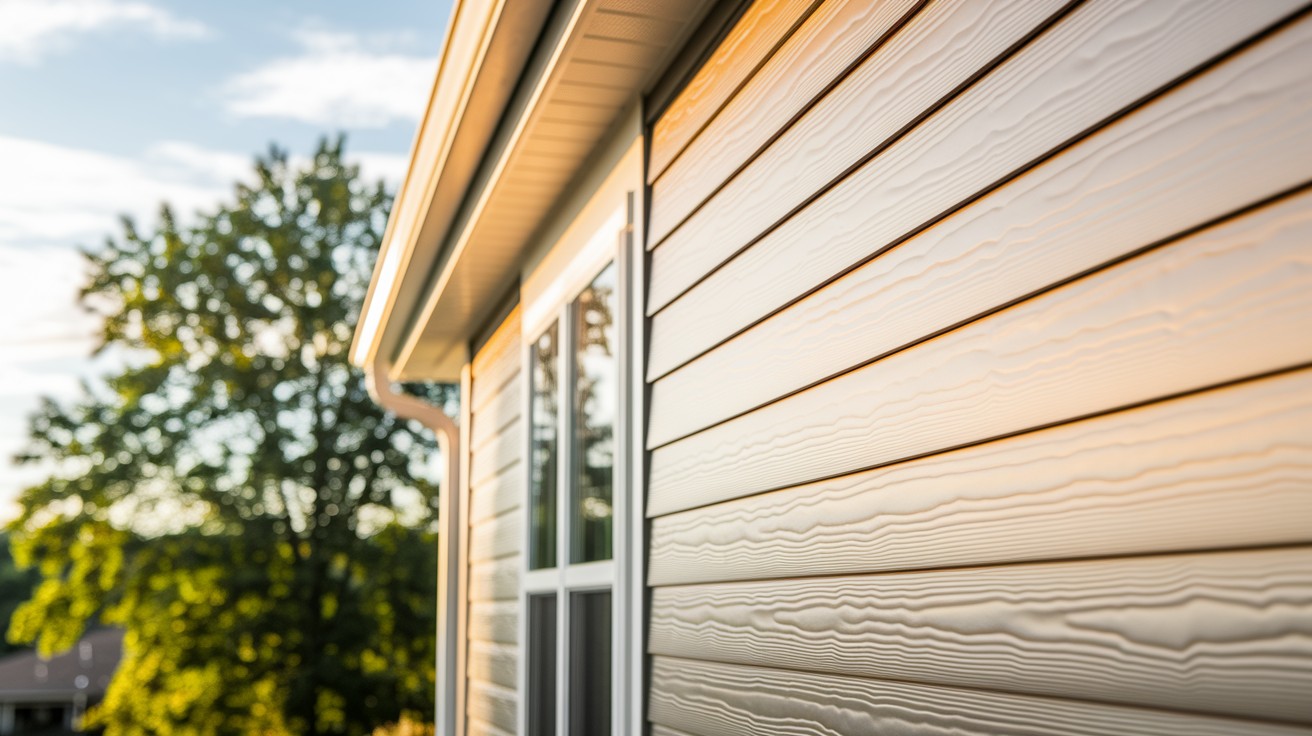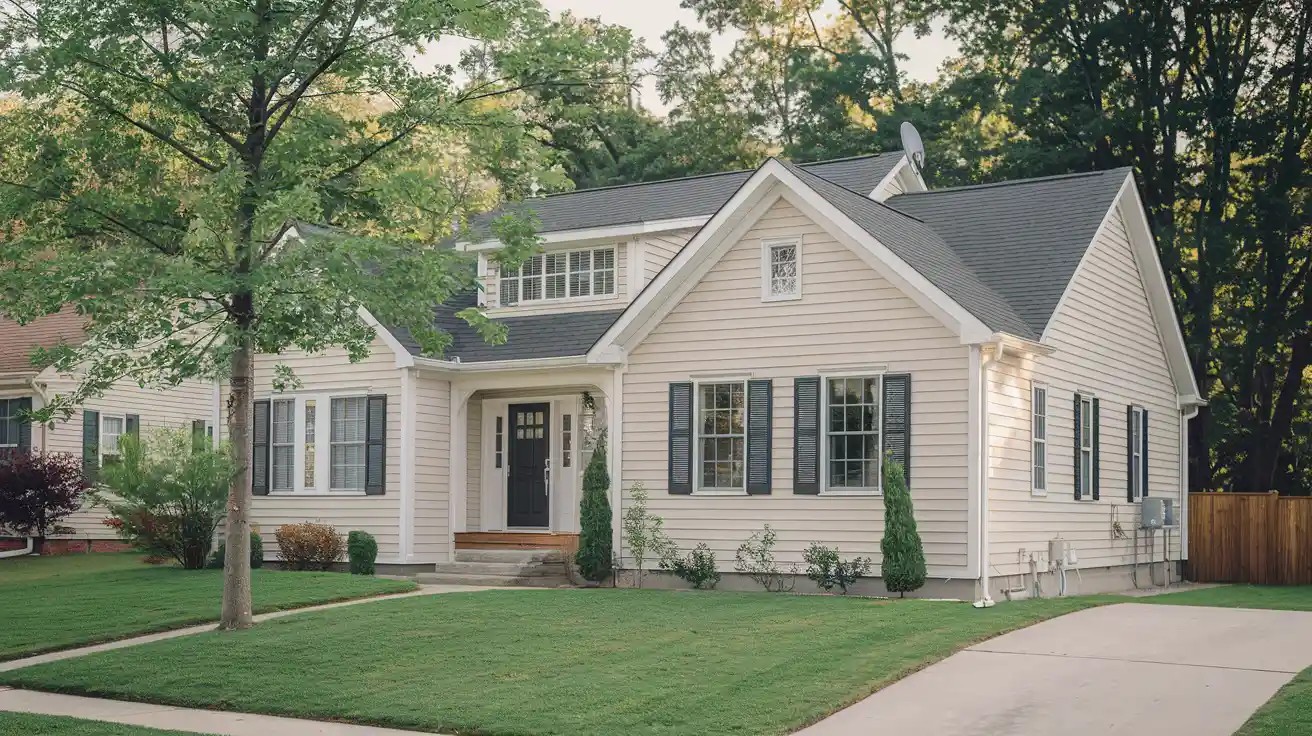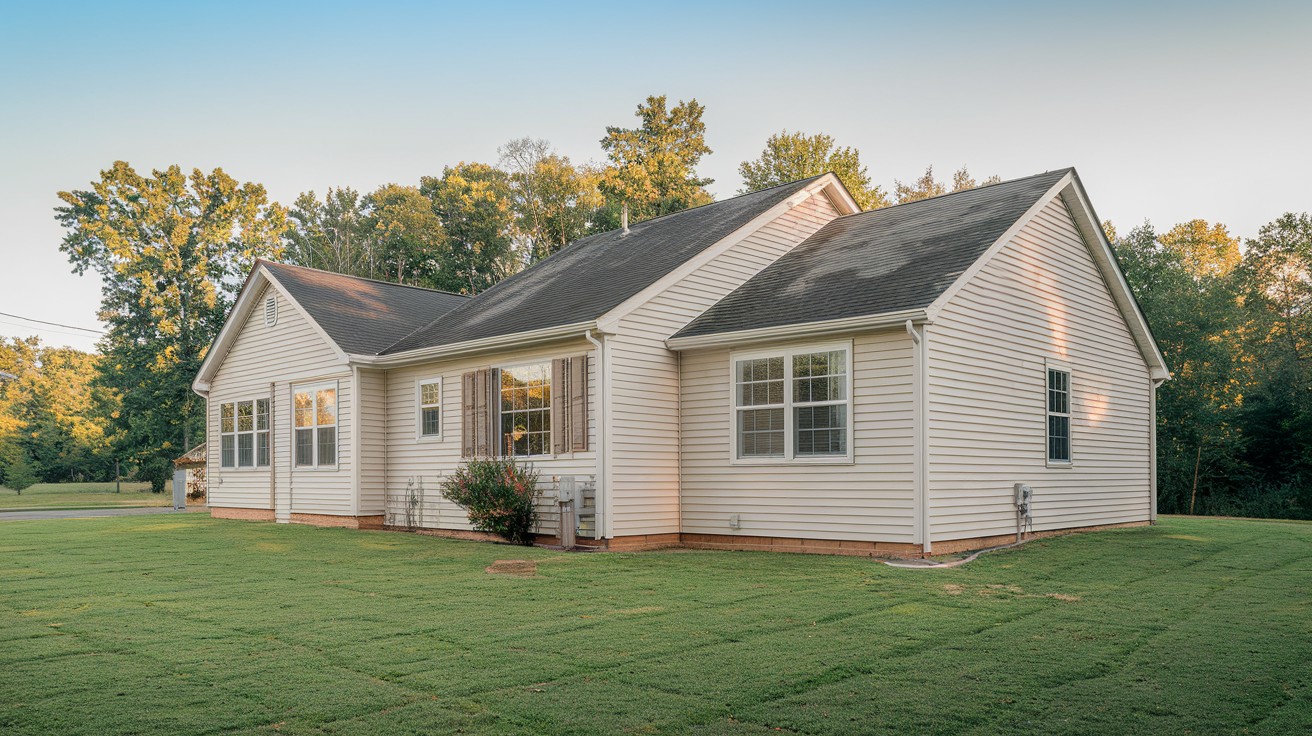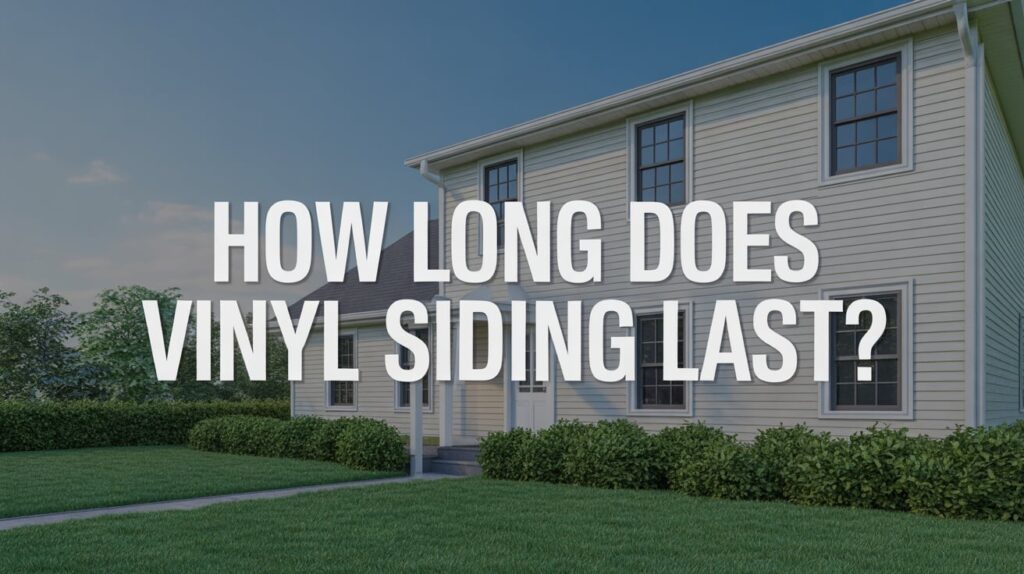Vinyl siding covers millions of homes across America. But if you’re considering it for your house, you probably want to know: how long will it last?
Most vinyl siding lasts between 20 to 40 years. Some high-quality options can go even longer with proper care.
Here’s the thing, though. The actual lifespan depends on several factors. Your local climate matters. Installation quality makes a huge difference. Even the color you choose affects how long it lasts.
In this guide, I’ll walk you through everything you need to know about vinyl siding’s lifespan. You’ll learn what factors affect durability.
Most homeowners don’t think about their siding until problems appear. But understanding what to expect helps you budget and plan.
You’ll make better decisions about repairs versus replacement. And you’ll know when to call professionals before small issues become big expenses.
Average Lifespan of Vinyl Siding

Most vinyl siding lasts 20 to 40 years. But that’s a pretty wide range, right?
The variation comes down to quality. Basic vinyl siding from big box stores might last 20 to 25 years. Premium brands can easily hit 30 to 40 years. Some manufacturers even offer 50-year warranties on their top-tier products.
Here’s what affects the range:
Budget-grade siding(20-25 years): Thinner panels, basic UV protection, limited color options.
Mid-grade siding(25-35 years): Better thickness, improved weather resistance, more color choices.
Premium siding(35-40+ years): Thickest panels, advanced UV protection, fade-resistant colors, enhanced durability features.
Most manufacturers back their products with warranties ranging from 20 to 50 years. But read the fine print. Many warranties are prorated, meaning coverage decreases over time.
Key Factors That Affect Vinyl Siding Lifespan

Several factors determine how long your vinyl siding will last. Let’s break them down,
Climate and Weather Exposure
Your local climate plays the biggest role in siding lifespan.
UV rays are vinyl’s biggest enemy. Constant sun exposure breaks down the material over time. This causes fading, chalking, and brittleness. Homes in Arizona or Florida face more UV damage than those in Seattle.
Temperature swings also take a toll. Vinyl expands in heat and contracts in cold. Extreme temperature changes stress the material. This leads to warping and cracking over time.
Humidity creates its problems. High moisture levels promote mold and mildew growth. This doesn’t just look bad, it can damage the siding material.
Severe weather like hail, high winds, or ice storms can cause immediate damage. Even small impacts weaken the material over time.
Installation Quality
Poor installation kills vinyl siding faster than anything else.
Professional installers know the proper techniques. They leave room for expansion. They use correct fastening methods. They ensure proper ventilation behind panels.
DIY installations often have problems.
Common mistakes include:
- Nailing too tightly
- Not leaving gaps at corners
- Poor flashing around windows and doors
- Inadequate moisture barriers
These mistakes lead to warping, cracking, and water damage. Always hire experienced professionals for installation.
Siding Thickness and Grade
Thicker vinyl siding lasts longer. It’s that simple.
Standard residential siding ranges from 0.035 to 0.055 inches thick. Thicker panels resist impacts better. They also handle temperature changes without warping.
Higher-grade materials include additional additives. These improve UV resistance, impact strength, and color retention. Premium siding costs more upfront but saves money over time.
Color and Heat Retention
Dark colors absorb more heat than light colors. This creates problems for vinyl siding.
Dark vinyl can reach temperatures over 160°F in direct sunlight.
This heat stress causes:
- Warping and distortion
- Premature fading
- Increased expansion and contraction
Light colors reflect heat better. They stay cooler and last longer. If you love dark colors, choose premium siding with better heat resistance.
Ongoing Maintenance and Care
Regular maintenance significantly extends siding life. Well-maintained vinyl siding can last 40+ years. Neglected siding might need replacement in 20 years or less.
Vinyl siding requires minimal maintenance compared to other materials. Simple cleaning and occasional repairs keep it looking great for decades.
Signs Your Vinyl Siding May Need Replacing

Cracks and Brittleness: Old vinyl becomes brittle and cracks easily. If you notice multiple cracks, especially after minor impacts, replacement time is near. Small cracks might seem harmless, but they allow moisture to seep behind panels.
Warping or Buckling Panels: Warped panels indicate serious problems. This usually happens from heat stress or poor installation. Warped panels don’t seal properly, allowing moisture infiltration. You’ll see gaps between panels or sections that stick out from the wall.
Faded or Chalky Appearance: Severely faded siding shows UV damage. The surface becomes chalky when you touch it. This means the protective coating has broken down, making the material vulnerable to further deterioration.
Mold or Moisture Damage: Mold behind panels signals bigger issues. This often indicates installation problems or damaged moisture barriers. Don’t ignore this—it can affect your home’s structure and indoor air quality.
Rising Energy Bills: Damaged siding allows air leaks. Your HVAC system works harder to maintain the temperature. If your energy bills are climbing without explanation, check your siding for gaps or damage.
Visible Storm Damage: Hail, wind, or debris can crack or dent panels. Check for less obvious damage too, like loosened panels or damaged trim pieces. Even small impacts can weaken the material over time.
If you notice several of these signs, it’s time to call a professional for assessment.
Tips to Extend the Life of Vinyl Siding
- Clean annually with mild soap and water. Use a soft brush for stubborn dirt.
- Keep heat sources away. Don’t place grills too close to the house.
- Fix minor damage immediately.Replace cracked panels before water gets behind them.
- Inspect yearly for loose panels, cracks, or damaged trim around windows.
- Choose quality materials from the start. Invest in thicker, higher-grade siding.
- Ensure proper ventilation behind panels to prevent moisture buildup.
- Trim vegetation away from your house to avoid scratches and moisture retention.
Vinyl Siding vs. Other Siding Materials
Here’s how vinyl siding compares to other popular options,
|
Material |
Lifespan |
Maintenance |
Cost |
Pros |
Cons |
|
Vinyl |
20-40 years |
Low |
Low-Medium |
Affordable, easy to clean, and good insulation |
Can crack, limited repair options |
|
Wood |
20-40 years |
High |
Medium-High |
Natural look, repairable, paintable |
Requires regular maintenance, pest issues |
|
Fiber Cement |
25-50 years |
Medium |
Medium-High |
Fire resistant, durable, paintable |
Heavy, can crack, needs periodic painting |
|
Metal |
40-70 years |
Low |
High |
Very durable, fire resistant, recyclable |
Expensive, can dent, noisy in the rain |
|
Brick |
100+ years |
Very Low |
High |
Extremely durable, low maintenance, classic look |
Expensive, limited design options |
Vinyl offers the best balance of cost, durability, and low maintenance for most homeowners. While it may not last as long as metal or brick, it’s much more affordable and easier to replace when needed.
When to Repair vs. When to Replace
Deciding between repair and replacement depends on the extent of damage and your siding’s age.
Choose repair when:
- Damage affects less than 30% of your siding
- Your siding is less than 20 years old
- Only a few panels are cracked or damaged
- The underlying structure is sound
- Replacement panels are still available
Choose replacement when:
- Damage affects more than 50% of your siding
- Your siding is over 30 years old
- You’re seeing widespread fading or brittleness
- Energy bills are rising due to air leaks
- Repair costs exceed 50% of replacement costs
Cost considerations: Individual panel replacement typically costs $3-8 per square foot. Full siding replacement runs $5-12 per square foot installed. If repairs approach half the cost of replacement, it’s usually better to replace everything.
Sometimes, partial replacement makes sense. You might replace just the south-facing side that gets the most sun damage. This buys you time while spreading out costs.
Conclusion
Vinyl siding typically lasts 20 to 40 years with proper care. The exact lifespan depends on climate, installation quality, material grade, and maintenance.
Quality matters more than you might think. Premium siding with professional installation can last 40+ years. Budget options might need replacement in 20 years.
Regular maintenance is your best investment. Simple cleaning and quick repairs can add years to your siding’s life. Watch for warning signs like cracks, warping, or fading.
Remember, siding protects your home’s structure. Don’t wait until problems become expensive repairs. Annual inspections catch issues early when they’re cheap to fix.
Your siding is a long-term investment. Choose quality materials, hire experienced installers, and maintain it properly. Do this, and you’ll enjoy beautiful, durable siding for decades to come.
Frequently Asked Questions
Can I install vinyl siding myself to save money?
While possible, I don’t recommend it. Poor installation is the #1 reason vinyl siding fails early. Professional installation includes proper techniques, warranties, and insurance coverage. The money you save on labor isn’t worth the risk of premature failure.
Does vinyl siding color affect its lifespan?
Yes, absolutely. Dark colors absorb more heat and can reach temperatures over 160°F. This heat stress causes warping, fading, and premature aging. Light colors reflect heat better and typically last longer. If you prefer dark colors, choose premium siding with better heat resistance.
How often should I clean my vinyl siding?
Clean your vinyl siding annually, or twice yearly if you live in a dusty area. Use mild soap and water with a soft brush. Avoid pressure washers on high settings—they can force water behind panels. Regular cleaning prevents buildup that can stain or damage the material.
What’s the difference between cheap and expensive vinyl siding?
Expensive siding is typically thicker (0.050+ inches vs. 0.035 inches), has better UV protection, includes impact-resistant additives, and comes with longer warranties. Premium siding also offers better color retention and more design options. The upfront cost difference pays for itself through a longer lifespan.
Can I replace just a few damaged panels, or do I need to replace all my siding?
You can replace individual panels if they’re available and the damage is localized. However, new panels may not match faded existing siding perfectly. If your siding is over 15 years old or damage is widespread, full replacement often makes more sense economically and aesthetically.

